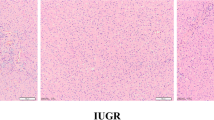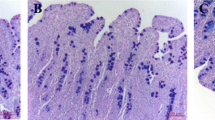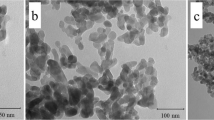Abstract
This study was conducted to investigate effects of dietary zinc oxide nanoparticles (nano-ZnOs) on growth, diarrhea rate, mineral deposition (Zn, Fe, and Mn), intestinal morphology, and barrier of weaned piglets. A total of 384 weaned piglets (Duroc × Landrace × Yorkshire) in 4 groups were fed a basal diet supplemented with 0, 400, and 800 mg/kg nano-ZnOs or 3000 mg/kg ZnO for 14 days. Compared with the control group, 800 mg/kg nano-ZnOs and 3000 mg/kg ZnO significantly increased average daily gain and decreased diarrhea rate of weaned piglets. There was no significant difference among ZnO and nano-ZnO groups. ZnO and nano-ZnOs did not affect serum activities of glutamic oxalacetic transaminase, glutamic-pyruvic transaminase, and lactate dehydrogenase. However, ZnO and 800 mg/kg nano-ZnOs significantly increased zinc concentrations in plasma, liver, pancreas, and tibia, without affecting Fe and Mn concentrations. Compared with the control group, 800 mg/kg nano-ZnOs significantly reduced plasma diamine oxidase activity, decreased total aerobic bacterial population in mesenteric lymph node, enhanced mRNA expressions of occludin, ZO-1, IL-1β, IL-10, TNF-α, and ki67 in ileal mucosa, and increased villous height, width, crypt depth, and surface area. Compared to ZnO group, 800 mg/kg nano-ZnOs significantly decreased aerobic bacterial population, enhanced mRNA expressions of occludin, IL-1β, IL-10, and TNF-α, and reduced fecal zinc concentration. These results indicated that 800 mg/kg nano-ZnOs might be a potential substitute for 3000 mg/kg ZnO in diets of weaned piglets.




Similar content being viewed by others
References
Liu ZH, Lu L, Li SF, Zhang LY, Xi L, Zhang KY, Luo XG (2011) Effects of supplemental zinc source and level on growth performance, carcass traits, and meat quality of broilers. Poult Sci 90(8):1782–1790
Wang Y, Tang JW, Ma WQ, Feng J, Feng J (2009) Dietary zinc glycine chelate on growth performance, tissue mineral concentrations, and serum enzyme activity in weanling piglets. Biol Trace Elem Res 133(3):325–334
Baker DH, Ammerman CA (1995) Zinc bioavailability. In: Ammerman CA et al (eds) Bioavailability of nutrients for animals: amino acids, minerals, and vitamins. Academic Press, San Diego, pp 367–398
Hu CH, Song ZH, Xiao K, Song J, Jiao le F, Ke YL (2014) Zinc oxide influences intestinal integrity, the expressions of genes associated with inflammation and TLR4-myeloid differentiation factor 88 signaling pathways in weanling pigs. Innate Immun 20(5):478–486
Poulsen HD (1995) Zinc oxide for weanling piglets. Acta Agric Scand A Anim Sci 45(3):159–167
Hahn JD, Baker DH (1993) Growth and plasma zinc responses of young pigs fed pharmacologic levels of zinc. J Anim Sci 71(11):3020–3024
NRC (1998) Nutrient requirements of swine: 10th revision. National Academy Press, Washington, DC
NRC (2012) Nutrient requirements of swine: 11 th revision. National Academy Press, Washington, DC
Jondreville C, Revy PS, Dourmad JY (2003) Dietary means to better control the environmental impact of copper and zinc by pigs from weaning to slaughter. Livest Prod Sci 84(2):147–156
Wahab R, Dwivedi S, Umar A, Singh S, Hwang IH, Shin HS, Musarrat J, Al-Khedhairy AA, Kim YS (2013) ZnO nanoparticles induce oxidative stress in Cloudman S91 melanoma cancer cells. J Biomed Nanotechnol 9(3):441–449
Bauer LA, Birenbaum NS, Meyer GJ (2004) Biological applications of high aspect ratio nanoparticles. J Mater Chem 14(4):517–526
Ma H, Williams PL, Diamond SA (2013) Ecotoxicity of manufactured ZnO nanoparticles–a review. Environ Pollut 172:76–85
Wahab R, Siddiqui MA, Saquib Q, Dwivedi S, Ahmad J, Musarrat J, Al-Khedhairy AA, Shin H-S (2014) ZnO nanoparticles induced oxidative stress and apoptosis in HepG2 and MCF-7 cancer cells and their antibacterial activity. Colloid Surf B 117:267–276
Antoine TE, Hadigal SR, Yakoub AM, Mishra YK, Bhattacharya P, Haddad C, Valyi-Nagy T, Adelung R, Prabhakar BS, Shukla D (2016) Intravaginal zinc oxide tetrapod nanoparticles as novel immunoprotective agents against genital herpes. J Immunol 196(11):4566–4575
Dwivedi S, Wahab R, Khan F, Mishra YK, Musarrat J, Alkhedhairy AA (2014) Reactive oxygen species mediated bacterial biofilm inhibition via zinc oxide nanoparticles and their statistical determination. PLoS One 9(11):e111289
Sirelkhatim A, Mahmud S, Seeni A, Kaus NHM, Ann LC, Bakhori SKM, Hasan H, Mohamad D (2015) Review on zinc oxide nanoparticles: antibacterial activity and toxicity mechanism. Nano-Micro Lett 7(3):219–242
Zhao CY, Tan SX, Xiao XY, Qiu XS, Pan JQ, Tang ZX (2014) Effects of dietary zinc oxide nanoparticles on growth performance and antioxidative status in broilers. Biol Trace Elem Res 160(3):361–367
Croteau MN, Dybowska AD, Luoma SN, Valsamijones E (2011) A novel approach reveals that zinc oxide nanoparticles are bioavailable and toxic after dietary exposures. Nanotoxicology 5(1):79–90
Muralisankar T, Bhavan PS, Radhakrishnan S, Seenivasan C, Manickam N, Srinivasan V (2014) Dietary supplementation of zinc nanoparticles and its influence on biology, physiology and immune responses of the freshwater prawn, Macrobrachium Rosenbergii. Biol Trace Elem Res 160(1):56–66
Wang C, Lu J, Zhou L, Li J, Xu J, Li W, Zhang L, Zhong X, Wang T (2016) Effects of long-term exposure to zinc oxide nanoparticles on development, zinc metabolism and biodistribution of minerals (Zn, Fe, cu, Mn) in mice. PLoS One 11(10):e0164434
Wang C, Cheng K, Zhou L, He J, Zheng X, Zhang L, Zhong X, Wang T (2017) Evaluation of long-term toxicity of oral zinc oxide nanoparticles and zinc sulfate in mice. Biol Trace Elem Res 178(2):276–282
Wang C, Zhang L, Su W, Ying Z, He J, Zhang L, Zhong X, Wang T (2017) Zinc oxide nanoparticles as a substitute for zinc oxide or colistin sulfate: effects on growth, serum enzymes, zinc deposition, intestinal morphology and epithelial barrier in weaned piglets. PLoS One 12(7):e0181136
Wedekind K, Lewis A, Giesemann M, Miller P (1994) Bioavailability of zinc from inorganic and organic sources for pigs fed corn-soybean meal diets. J Anim Sci 72(10):2681–2689
Demirbaş A (1999) Proximate and heavy metal composition in chicken meat and tissues. Food Chem 67(1):27–31
Dong L, Zhong X, Ahmad H, Li W, Wang Y, Zhang L, Wang T (2014) Intrauterine growth restriction impairs small intestinal mucosal immunity in neonatal piglets. J Histochem Cytochem 62(7):510–518
Livak KJ, Schmittgen TD (2001) Analysis of relative gene expression data using real-time quantitative PCR and the 2−ΔΔCT method. Methods 25(4):402–408
Talebian N, Amininezhad SM, Doudi M (2013) Controllable synthesis of ZnO nanoparticles and their morphology-dependent antibacterial and optical properties. J Photoch Photobiol B 120:66–73
Yamamoto O (2001) Influence of particle size on the antibacterial activity of zinc oxide. Int J Inorg Mater 3(7):643–646
Gajjar P, Pettee B, Britt DW, Huang W, Johnson WP, Anderson AJ (2009) Antimicrobial activities of commercial nanoparticles against an environmental soil microbe, pseudomonas putida KT2440. J Biol Eng 3(1):9–21
Hu C, Song J, You Z, Luan Z, Li W (2012) Zinc oxide–montmorillonite hybrid influences diarrhea, intestinal mucosal integrity, and digestive enzyme activity in weaned pigs. Biol Trace Elem Res 149(2):190–196
Hadley JA, Fowler DR (2003) Organ weight effects of drowning and asphyxiation on the lungs, liver, brain, heart, kidneys, and spleen. Forensic Sci Int 133(3):190–196
Andersen H, Larsen S, Spliid H, Christensen ND (1999) Multivariate statistical analysis of organ weights in toxicity studies. Toxicology 136(2–3):67–77
Wang B, Feng WY, Wang TC, Jia G, Wang M, Shi JW, Zhang F, Zhao YL, Chai ZF (2006) Acute toxicity of nano- and micro-scale zinc powder in healthy adult mice. Toxicol Lett 161(2):115–123
Wang B, Feng W, Wang M, Wang T, Gu Y, Zhu M, Ouyang H, Shi J, Zhang F, Zhao Y (2008) Acute toxicological impact of nano-and submicro-scaled zinc oxide powder on healthy adult mice. J Nanopart Res 10(2):263–276
Sharma V, Singh P, Pandey AK, Dhawan A (2012) Induction of oxidative stress, DNA damage and apoptosis in mouse liver after sub-acute oral exposure to zinc oxide nanoparticles. Mutat Res 745(1):84–91
Maincent P, Le Verge R, Sado P, Couvreur P, Devissaguet JP (1986) Disposition kinetics and oral bioavailability of vincamine-loaded polyalkyl cyanoacrylate nanoparticles. J Pharm Sci 75(10):955–958
Langer R (1998) Drug delivery and targeting. Nature 392(6679 Suppl):5–10
Wang MQ, Li H, He YD, Wang C, Tao WJ, Du YJ (2012) Efficacy of dietary chromium (III) supplementation on tissue chromium deposition in finishing pigs. Biol Trace Elem Res 148(3):316–321
Rincker M, Hill G, Link J, Meyer A, Rowntree J (2005) Effects of dietary zinc and iron supplementation on mineral excretion, body composition, and mineral status of nursery pigs. J Anim Sci 83(12):2762–2774
Meyer T, Lindemann M, Cromwell G, Monegue H, Inocencio N (2002) Effects of pharmacological levels of zinc as zinc oxide on fecal zinc and mineral excretion in weanling pigs. Prof Anim Sci 18(2):162–168
Lee H, Park JH, Park DI, Kim HJ, Cho YK, Sohn CI, Jeon WK, Kim BI, Chae SW (2013) Mucosal mast cell count is associated with intestinal permeability in patients with diarrhea predominant irritable bowel syndrome. J Neuro-Oncol 19(2):244–250
Turner JR (2009) Intestinal mucosal barrier function in health and disease. Nat Rev Immunol 9(11):799–809
Tossou MC, Liu H, Bai M, Chen S, Cai Y, Duraipandiyan V, Liu H, Adebowale TO, Aldhabi NA, Long L (2016) Effect of high dietary tryptophan on intestinal morphology and tight junction protein of weaned pig. Biomed Res Int 2016(2):1–6
Gautreaux MD, Deitch EA, Berg RD (1994) Bacterial translocation from the gastrointestinal tract to various segments of the mesenteric lymph node complex. Infect Immun 62(5):2132–2134
Zareie M, Johnson HK, Jury J, Yang PC, Ngan BY, Mckay DM, Soderholm JD, Perdue MH, Sherman PM (2006) Probiotics prevent bacterial translocation and improve intestinal barrier function in rats following chronic psychological stress. Gut 55(11):1553–1560
Fanning AS, Jameson BJ, Jesaitis LA, Anderson JM (1998) The tight junction protein ZO-1 establishes a link between the transmembrane protein occludin and the actin cytoskeleton. J Biol Chem 273(45):29745–29753
Zhang B, Guo Y (2009) Supplemental zinc reduced intestinal permeability by enhancing occludin and zonula occludens protein-1 (ZO-1) expression in weaning piglets. Brit J Nutr 102(5):687–693
Shao YX, Lei Z, Wolf PG, Gao Y, Guo YM, Zhang BK (2017) Zinc supplementation, via GPR39, upregulates PKCζ to protect intestinal barrier integrity in caco-2 cells challenged by salmonella enterica serovar typhimurium. J Nutr 147(7):1282–1289
Rodney WJ, Jeffery E, Douglas MW (2001) Nutrition and immunology of swine. In: Austin J et al (eds) Swine nutrition, 2nd edn. CRC Press, New York, pp 545–562
Pié S, Lallès J, Blazy F, Laffitte J, Sève B, Oswald I (2004) Weaning is associated with an upregulation of expression of inflammatory cytokines in the intestine of piglets. J Nutr 134(3):641–647
Hu C, Xiao K, Song J, Luan Z (2013) Effects of zinc oxide supported on zeolite on growth performance, intestinal microflora and permeability, and cytokines expression of weaned pigs. Anim Feed Sci Technol 181(1):65–71
Li B, Van Kessel A, Caine W, Huang S, Kirkwood R (2001) Small intestinal morphology and bacterial populations in ileal digesta and feces of newly weaned pigs receiving a high dietary level of zinc oxide. Can J Anim Sci 81(4):511–516
Hu C, Gu L, Luan Z, Song J, Zhu K (2012) Effects of montmorillonite–zinc oxide hybrid on performance, diarrhea, intestinal permeability and morphology of weanling pigs. Anim Feed Sci Technol 177(1):108–115
Bullwinkel J, BaronLühr B, Lüdemann A, Wohlenberg C, Gerdes J, Scholzen T (2006) Ki-67 protein is associated with ribosomal RNA transcription in quiescent and proliferating cells. J Cell Physiol 206(3):624–635
Kausch I, Lingnau A, Endl E, Sellmann K, Deinert I, Ratliff TL, Jocham D, Sczakiel G, Gerdes J, Böhle A (2003) Antisense treatment against Ki-67 mRNA inhibits proliferation and tumor growth in vitro and in vivo. Int J Cancer 105(5):710–716
VanDussen KL, Carulli AJ, Keeley TM, Patel SR, Puthoff BJ, Magness ST, Tran IT, Maillard I, Siebel C, Kolterud Å (2012) Notch signaling modulates proliferation and differentiation of intestinal crypt base columnar stem cells. Development 139(3):488–497
Carulli AJ, Keeley TM, Demitrack ES, Chung J, Maillard I, Samuelson LC (2015) Notch receptor regulation of intestinal stem cell homeostasis and crypt regeneration. Dev Biol 402(1):98–108
Acknowledgements
This work was financially supported by the Fundamental Research Funds for the Central Universities (Grant No. KYZ201643), A Project funded by the Priority Academic Program Development of Jiangsu Higher Education Institutions II (PAPD II) and Zhangjiagang Bonded Area Hualu Nanometer Material Co., Ltd. (China, Jiangsu). Thanks for the help of Liren Ding (College of Animal Science and Technology, Nanjing Agricultural University) in dealing with samples for the analysis of mineral concentrations.
Author information
Authors and Affiliations
Corresponding author
Ethics declarations
Experiments were approved and conducted under the supervision of the Institutional Animal Care and Use Committee of Nanjing Agricultural University, China.
Electronic supplementary material
ESM 1
(DOCX 16 kb)
Rights and permissions
About this article
Cite this article
Wang, C., Zhang, L., Ying, Z. et al. Effects of Dietary Zinc Oxide Nanoparticles on Growth, Diarrhea, Mineral Deposition, Intestinal Morphology, and Barrier of Weaned Piglets. Biol Trace Elem Res 185, 364–374 (2018). https://doi.org/10.1007/s12011-018-1266-5
Received:
Accepted:
Published:
Issue Date:
DOI: https://doi.org/10.1007/s12011-018-1266-5




